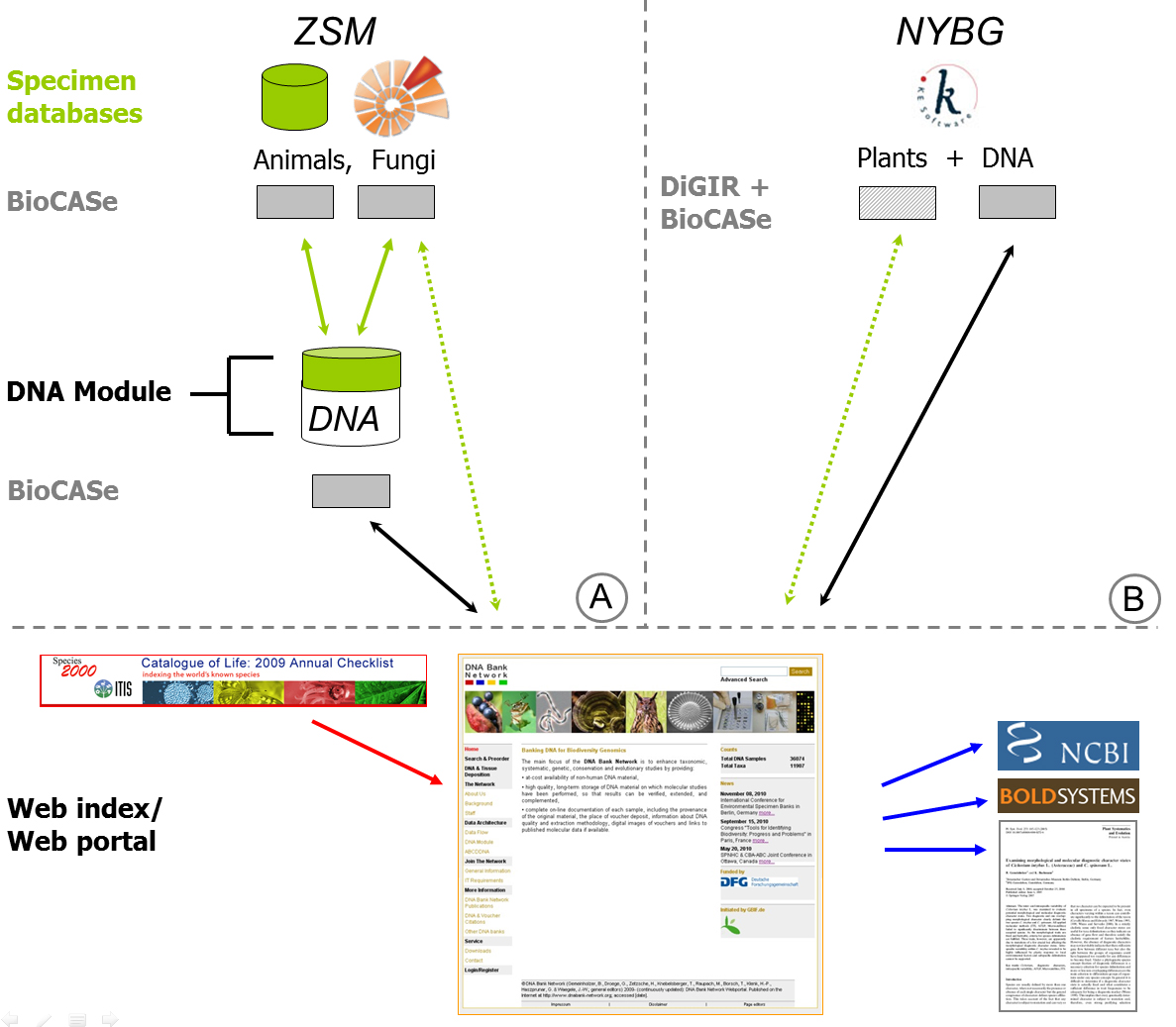Difference between revisions of "Data Portal Architecture"
(→Level 2) |
|||
| Line 1: | Line 1: | ||
=Level 1= | =Level 1= | ||
| − | <div id="wikinote">Within | + | <div id="wikinote">Within GGBN specimen data are recalled by the same data pipelines which are used by [http://www.gbif.org/ GBIF].</div> |
| − | The data architecture of the | + | The data architecture of the GGBN is based on the [http://www.gbif.org/ GBIF] infrastructure. The basic principle of GBIF as well as of the GGBN is to record all data sets only once. Stored at only one place they can be used as a linked reference for different applications. |
Since many institutions joined GBIF applying different database structures each, the installation of wrappers has become a standard to combine different sources and integrate data easily into networks. There are three main wrapper softwares available [http://www.biocase.org/ BioCASE], [http://digir.sourceforge.net/ DiGIR] and [http://www.tdwg.org/activities/tapir/ TAPIR]. All of them use a xml schema for data transfer: [http://www.biocase.org/ BioCASE] - [http://www.bgbm.org/tdwg/codata/schema/ ABCD], [http://digir.sourceforge.net/ DiGIR] and [http://www.tdwg.org/activities/tapir/ TAPIR] - [http://wiki.tdwg.org/twiki/bin/view/DarwinCore/WebHome DarwinCore(DwC)]. | Since many institutions joined GBIF applying different database structures each, the installation of wrappers has become a standard to combine different sources and integrate data easily into networks. There are three main wrapper softwares available [http://www.biocase.org/ BioCASE], [http://digir.sourceforge.net/ DiGIR] and [http://www.tdwg.org/activities/tapir/ TAPIR]. All of them use a xml schema for data transfer: [http://www.biocase.org/ BioCASE] - [http://www.bgbm.org/tdwg/codata/schema/ ABCD], [http://digir.sourceforge.net/ DiGIR] and [http://www.tdwg.org/activities/tapir/ TAPIR] - [http://wiki.tdwg.org/twiki/bin/view/DarwinCore/WebHome DarwinCore(DwC)]. | ||
Revision as of 20:43, 7 December 2015
Level 1
The data architecture of the GGBN is based on the GBIF infrastructure. The basic principle of GBIF as well as of the GGBN is to record all data sets only once. Stored at only one place they can be used as a linked reference for different applications.
Since many institutions joined GBIF applying different database structures each, the installation of wrappers has become a standard to combine different sources and integrate data easily into networks. There are three main wrapper softwares available BioCASE, DiGIR and TAPIR. All of them use a xml schema for data transfer: BioCASE - ABCD, DiGIR and TAPIR - DarwinCore(DwC).
Level 2
The DNA Module is one of key components of the networks database system. To find related specimen data of a DNA sample the module sends a query to the respective specimen database via BioCASE or DiGIR. A copy including few specimen attributes is as well stored in the DNA cache (speed up queries). By following the BioCASe and DiGIR protocol it is so possible to connect any GBIF compliant specimen database worldwide.
The DNA Module is currently used by three of the four project partners associated with their own specimen databases. The DSMZ in Braunschweig applies its own system for DNA data input.
Level 3
Another BioCASE wrapper using the new DNA extension for ABCD has been installed on all three DNA Modules and the database in Braunschweig separately to offer all DNA samples and its related specimen data on the central webportal.
The source code of the DNA Bank Network's Webportal is available under Mozilla Public License Version 1.1 at http://ww2.biocase.org/svn/dnabank/DNA_Bank_Network/webportal/
General data architectur of the DNA Bank Network. Specimen and DNA sample databases (on top and middle) are operated by the Network partners. Their data content is structured and transferred to the shared web portal (black and green arrows) by wrappers (BioCASe, DiGIR, grey boxes). Publications and online accessible DNA sequence data (blue arrows) can be linked to the related DNA sample. The Catalogue of Life checklist is used as search backbone in the Web portal (red arrow).
